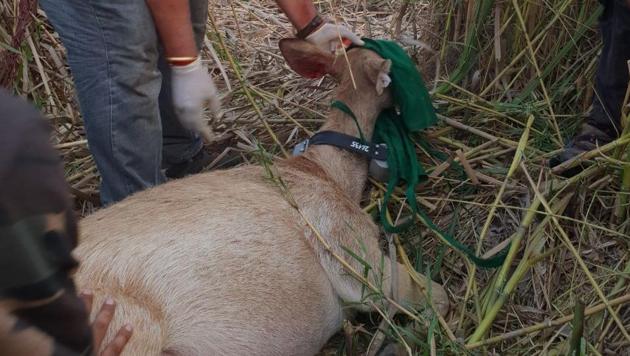2 swamp deer get radio collars, eye on breeding pattern
Wildlife Institute of India (WII) has radio collared two female swamp deer -- popularly called barasingha -- within a month in Jhilmil Jheel Conservation Reserve in Haridwar to study their movement along Ganga river and breeding pattern
Wildlife Institute of India (WII) has radio collared two female swamp deer -- popularly called barasingha -- within a month in Jhilmil Jheel Conservation Reserve in Haridwar to study their movement along Ganga river and breeding pattern.

Funded by the Uttarakhand forest department, the Dehradun-based institute received permission from the union environment forest and climate change (MoEFCC) ministry to radio collar six deers last year.
The project titled ‘study on movement pattern and inbreeding status of swamp deer in Jhilmil Jheel’ started in 2016. In the first phase, experts took up genetic study on deer found along the river.
It is a presumption that the specie, which is spotted in the conservation reserve from November till July, is likely to be breeding in Hastinapur Wildlife Sanctuary in Uttar Pradesh.
During their study, the experts never reported presence of young ones in the reserve. Meanwhile, evidences of genetic exchange were also recorded in a few pockets between Hastinapur and the reserve.
The specie is kept under ‘vulnerable’ category by the International Union for Conservation of Nature (IUCN). It is a Schedule I specie under the Wildlife Protection Act, 1972.
“For us, it was important to know their breeding ground. If the specie is reaching in large number in Jhilmil then where is it going post monsoon? This question needed to be answered due to which we roped in WII,” said DVS Khati, the chief wildlife warden.
Jhilmil reserve spreads across 3,783.500 hectare and has nearly 325 barasingha.
GPS iridium collars were fitted on the neck of two female deer aged 3-4 years. The operation was headed by WII experts -- Parag Nigam, Vinod Thakur, Samrat Mondal and Bivash Pandav.
The first deer was captured and radio collared on May 30. It left the conservation reserve on June 7 and is close to Hastinapur, the experts said.
The second deer was collared on Friday. “The specie has immense ecological significance. As the monsoon sets in Uttarakhand, nearly 95% of the swamp deer used to vacate Jhilmil. There was a need to study about their calving habitat,” Pandav said.
The rainfall has led to massive growth of shrubs around the reserve owing to which it seem difficult to radio collar more animals. But, as and when the climatic conditions will become favourable, they will attempt collaring for the remaining animals.
In May, the National Green Tribunal issued notices to the MoEFCC and the UP government on a public interest litigation claiming that swamp deer is facing risk in Hastinapur.
The plea quoted another WII report that blamed human intervention for the threat. The parties have to submit their reply before the NGT on the notice by July 23.






